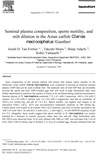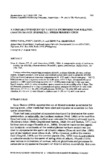Seminal plasma composition, sperm motility, and milt dilution in the Asian catfish Clarias macrocephalus (Gunther)
- Global styles
- MLA
- Vancouver
- Elsevier - Harvard
- APA
- Help
Share
抄録
Ionic composition of the seminal plasma and factors that initiate sperm motility in the freshwater Asian catfish Clarias macrocephalus, were examined to develop an artificial seminal plasma (ASP) that can be used to dilute milt. The optimum ratio of milt:ASP that can reversibly activate the sperm and milt–ASP:ovulated eggs that will result in high fertilization rates were further determined to minimize the number of males to be sacrificed during artificial insemination. Seminal plasma of C. macrocephalus contained 17.8±0.1 mM/l potassium, 164.4±0.6 mM/l sodium, 8.4±0.0 mM/l calcium and 1.6±0.0 mM/l magnesium, and had an osmolality of 269.0±6.4 mOsm/kg, and pH of 7.8±0.2. Sperm motility was highest and longest in all electrolyte (NaCl, CaCl2, KCl) and non-electrolyte (mannitol) solutions of 200 mOsm/kg. Catfish sperm were motile in all isotonic NaCl–KCl solutions, and were reversibly activated in the ASP (143 mM NaCl, 30 mM KCl, 8 mM CaCl2, 2 mM MgCl2, 10 mM HEPES) solutions of pH 6.4–9.4. Altogether, these results suggest that sperm motility in C. macrocephalus was mainly initiated by a decrease in osmotic pressure, rather than ions and pH. High fertilization rates (89–94%) were observed when 10 μl milt, diluted with 1000 μl ASP, was activated with 5 ml of 0.6% NaCl (198.24 mOsm/kg) to fertilize 5 or 10 g of ovulated eggs. Results obtained from the present study provide information on sperm physiology that will lead to more efficient gamete management, and hopefully, an increase in the yield of catfish fry in the hatchery.
Suggested Citation
Tan-Fermin, J. D., Miura, T., Adachi, S., & Yamauchi, K. (1999). Seminal plasma composition, sperm motility, and milt dilution in the Asian catfish Clarias macrocephalus (Gunther). Aquaculture , 171(3-4), 323-338. https://doi.org/10.1016/S0044-8486(98)00402-5
Type
ArticleISSN
0044-8486Collections
- Journal Articles [1258]
Related items
Showing items related by title, author, creator and subject.
-
Influence of LHRHa and methyltestosterone on milt production of sea bass Lates calcarifer (Bloch)
Hilomen-Garcia, G. V.; Baldevarona, R. B.; Lacanilao, F. J. (Aquaculture Department, Southeast Asian Fisheries Development Center, 1996)Milt volume, sperm density, and number of spermatozoa were determined to quantify milt production of mature sea bass after a single injection of LHRHa [(D-Ala6,Pro9-N-ethylamiide)LHRH] in saline solution and 17α-methyltestosterone ... -
A comparative study of various extenders for milkfish, Chanos chanos (Forsskal), sperm preservation
Hara, Shiro; Canto, Jose T., Jr.; Almendras, Jesus M. E. (Elsevier, 1982)Various extenders, containing potassium chloride, sodium chloride, glucose, sodium citrate, Ringer's solution, cow serum and milkfish serum were used to preserve milkfish (Chanos chanos) sperm at near-zero temperatures ... -
Reproductive quality of male Penaeus monodon
Gomes, Luiz A. O.; Honculada-Primavera, J. (Elsevier, 1993)The reproductive performance of unilaterally eyestalk-ablated wild male Penaeus monodon was compared with that of unablated prawns (controls). After being stocked for 6 weeks in flow-through tanks, ablated males showed ...





